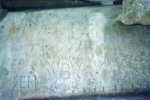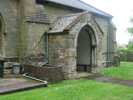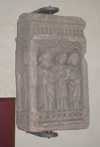For this church:    |
|
 Graffitti on the Graffitti on theNewmarch tomb |
A year later in 1808 more major work was carried out on the fabric. The south transept was pulled down and the south aisle rebuilt and, under the influence of Thomas Dickinson Hall, lord of the manor, completed in stuccoed brick. The east end of this aisle was also serving as the village school, and graffiti by the children can be seen on the tomb of Sir Hugh Newmarch.
In 1801 the population of Whatton was 308. By 1821 it had risen to 390, 196 males and 194 females. In another twenty years it rose to a peak of 532 recorded in the census return of 1841, although that did include 83 strangers at the annual feast. The population then declined slowly until in 1891 it was 281.
The Methodists, who were to feature in a small way in St John’s history later in the century, appeared in 1825 when they built a chapel in the village.
By 1846 the chancel had fallen into bad repair and Thomas Dickinson Hall paid the bill to rebuild, unfortunately 3 feet shorter than the original.
At the time of the 1851 religious census, the Rev Thomas Hall noted that the morning general congregation was 80 and the afternoon 120. He recorded 44 Sunday School scholars at each service.
Plans for further rebuilding must have been under discussion, because in 1854-5 the Architectural Society of the Diocese of Lincoln reported that:
the plans for rebuilding ... had been before the Nottingham Committee who ... strongly recommended that as much as possible of the original features be retained in order that as a memorial to the great archbishop [Cranmer] it may present as nearly as possible the same appearance as it had when the Cranmers were connected.
 The north porch The north porch |
However, it would seem the only rebuilding to take place at this time was of the north porch in 1858, because in 1862-3 another report – by the Association of Architectural Societies – appeared. This read that:
... cruciform church ... fine massive tower, ... greater part of the church in Early English ... the tower surmounted by perpendicular pinnacles and a decorated spire of insignificant height, resting upon a Norman tower with a doorway relic of former fabric ... many alterations made of different periods ... present north aisle in decorated style ... fine tracery in the west window ... others sadly mutilated in modern days ... Stucco-covered south aisle ... been rebuilt, ... above some small circular clerestory lights thought by some to have been of earlier date but probably not so. North porch rebuilt a few years earlier, approximately 1858. Traces of an adjacent staircase and Early English doorway still remain.
Six years later in May 1869 a faculty for restoring and re-seating the church was granted. This was on behalf of Thomas Dickinson Hall, patron, George Longstaff, vicar, and John Innocent and Edward Wadsworth, churchwardens. It involved taking down and rebuilding the tower and spire to their present outlines and dimensions, and increasing the height of the tower walls by three feet, putting in arches in the east and west walls of the tower, re-roofing the nave, preserving the existing piers and substituting open benches with seats and boarding the floors plus other alterations and improvements. The cost of this work was estimated at £1800 by the architects S C Hind and Son of Nottingham.
The rebuild took place in 1870-71 and was supervised by Thomas Butler the rector of Langar and father of Samuel Butler, the author of Erewhon.
In 1871 the Association of Architectural Societies had another say:
... regretted services of a most able conservative architect were not employed ... more of the old fabric would have been preserved ... lower part of tower was Norman, having semicircular arches opening into nave ... a lost south transept ... tower rebuilt and Norman south arch of old tower replaced on the north side ... belfry windows of present tower are Early English rather than decorated and therefore do not agree with remainder ... re-roofed nave is of a better pitch and the old circular lights of clerestory replaced by decorated quatrefoils ... the south aisle is now encased in stone and new tracery in the windows ...
The Lincoln Diocese Architectural Society report remarked that ‘Mr Woodyear once proposed would have been better at restoration’. At about the same time as all this activity the present south porch was also built.
 Fragment of Fragment ofancient cross |
In 1877 the remains of an ancient cross were found in Aslockton (now seen in the south aisle) and Samuel White made an organ stool and platform for a new organ. He also repaired the belfry floor which could now be reached by an exterior staircase. Previously the five bells had been rung from the chancel.
The new organ was opened and dedicated on 19 April 1878. It was decided the gallery at the west end was no longer needed and it was removed. This caused dissention with the members of the gallery band, who defected to the aforementioned Methodist Chapel in protest, where they stayed for some time.
Besides the opening of the new organ, the two years from 1878-1880 saw a new east window in the south aisle, made by William Morris from a design by Edward Burne-Jones and encaustic tiles and iron gratings placed in the floor under the tower.
Ongoing changes and restoration continued up to the end of the century. In 1880 the chancel floor was raised and tiled and the slab in memory of Robert Gelsthorpe – died 1862 – was relaid north to south under the altar.
Eight years later a faculty was issued for a reredos in the form of a triptych that included the church’s patron saint, and in 1890 and 1891 new windows were put in – the chancel north window by Heaton Butler and Bayne, a window to the west of the south door in the south aisle and the west window.
By 1894 the population stood at 281. The parish covered 1759 acres and the rateable value was given as £3990. The vicarage valued at £5 6s 8d in the King’s Book was now valued at £70.
Before the century closed roof repairs had to be carried out in 1896 at a cost of £60 and a window by C E Kempe was installed in the chancel south wall.
After a hundred years in which the structure of the church had been significantly altered, the twentieth century has seen relatively minor changes.
In 1906 a new coke boiler was installed and in 1910 the old clock was removed and a clock with a dial installed. Outside in the churchyard several large lime trees and yews were removed in 1908 and replaced with pink thorn trees. The arrangement whereby Whatton and Aslockton used the churchyard had expired in 1892.
In 1912, when Rev F H Lane was the incumbent, the income had increased to £123; there were 42 children on the roll of the Church school and 22 on the roll of the Sunday School. In the previous year six children had been baptised and six confirmations had taken place.
Just before the start of World War I the ring of bells was increased to six with the addition of a new treble bell. This was in 1913 and the next year a new belfry had to be put in.
In May 1914 on the 19th at 3pm Edwyn Hoskyns, Bishop of Southwell, made a visitation. This recorded that:
the vicar was F H Lane
the net annual value of the benefice was £123
the population in 1911 was 250
the church accommodated 350 and the church day school roll was 42
the Sunday School had 22
Baptisms in 1912 were 6 and confirmations in that year were also 6.
1933 saw the boiler replaced with new and a major overhaul of the clock undertaken. This involved painting and gilding the dial and putting in two steel wire weight lines.
When foundations were dug for a boiler room in 1956 the lower parts of the north aisle wall were exposed and a year later the east end of the north aisle was partially restored and re-dedicated to Thomas Cranmer on 26 September 1957.
Money raised by the ringers and parishioners in 1969 paid for two further bells, raising the ring to 8, and in 2001 trustees and friends of the church donated towards the repair and the fitting of an automatic winding system to the clock to celebrate the second millennium.






